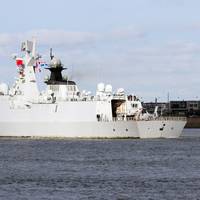China is Building an Armada

It took time for China's naval shipyards to hit their straps. For about a decade from the turn of this century, they experimented with new designs, in some cases launching just a couple of each new type of warship for evaluation.The yards absorbed foreign technology, imported some key components and developed local know-how. Quality ruled over quantity. Then they started mass production. New hulls cascaded into the water, mainly from the big shipyards at Shanghai, Dalian, Guangzhou and Wuhan.These yards have been building the full spectrum of warships and support vessels…
Trump to Unveil China Tariff List
The Trump administration this week will unveil the list of Chinese imports targeted for U.S. tariffs to punish Beijing over technology transfer policies, a move expected to intensify trade tensions between the world's two largest economies. The list of $50 billion to $60 billion worth of annual imports is expected to target "largely high-technology" products and it may be more than two months before tariffs take effect, administration officials have said. The U.S. Trade Representative's office needs to unveil the list of products by Friday under President Donald Trump's China tariff proclamation signed on March 22. The tariffs are aimed at forcing changes to Chinese government policies that USTR says results in the "uneconomic" transfer of U.S. intellectual property to Chinese companies.
Arctic Shelf Oil Could Meet 3.5% of Russia's Production
According to the optimistic forecast, oil production on the Russian Arctic shelf by 2030 will reach only 18 mln tonnes per year, Vasily Bogoyavlensky, Research Director of Oil and Gas Institute of the Russian Academy of Sciences said. "I believe that in the next 15 years until 2030 shelf with oil will not help us. According to overoptimistic forecast, if the development of all open fields begins, best-case scenario is that in 2030 we will reach 18 mln tonnes, which is 3.5% of our annual production," expert said. At the same time, the expert spoke optimistically about the possibilities of import substitution of the equipment for the development of offshore fields.
Economic Sanctions Update: Door Opens to U.S. Business in Libya, Closes on Syria
By Barbara D. Recent changes to U.S. economic sanctions programs have resulted in both new opportunities and new restrictions for offshore service vessel operators. In April, the United States substantially reduced restrictions on trade with Libya. However, these actions were followed in early May by the imposition of a new embargo against Syria. In addition, over the past several months, many additional individuals and entities have been designated as subject to trade sanctions, and the Secretary of Homeland Security has been granted authority to take various measures to prevent the unauthorized entry of vessels into Cuban territorial waters.
High Royalties to Cut Into Shipbuilding Profits
South Korean shipbuilders are paying large royalties on a core foreign technology for manufacturing liquefied natural gas (LNG) carriers, causing a big reduction in their earnings, The Korea Times reports. To build LNG carriers, most South Korean and foreign shipbuilders currently use a membrane containment system developed by Gaz Transport & Technigaz of France, a key technology for freezing and storing gas in tanks for transport. South Korean shipbuilders' profit margin amounts to about 10 percent of a carrier's order price, of which nearly 5 percent is paid to the French company in royalties, according to the report. The nation's shipbuilders charge an average $200 million for each LNG carrier.









